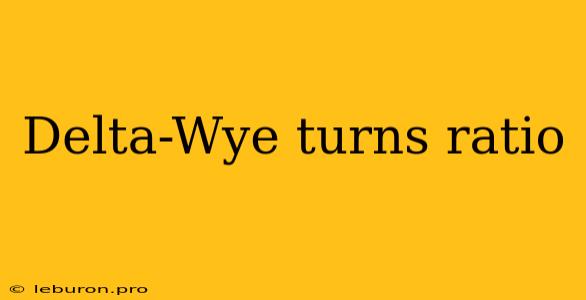The Delta-Wye transformation, also known as the Delta-Y transformation, is a fundamental concept in electrical engineering that allows for the analysis and calculation of equivalent circuits. This transformation is particularly useful when dealing with three-phase systems, where it enables the conversion between delta-connected and wye-connected loads. The key element in this transformation is the Delta-Wye turns ratio, which represents the relationship between the voltage and current in the two configurations. This article will delve into the intricacies of the Delta-Wye turns ratio, providing a comprehensive understanding of its applications, calculation, and significance in electrical circuits.
Understanding the Delta-Wye Transformation
Before exploring the Delta-Wye turns ratio, it is essential to understand the basic concepts of delta and wye connections.
Delta Connection
In a delta connection, the three phases of a three-phase system are connected in a closed loop, forming a triangle. The three terminals of the load are connected to the corners of this triangle. In this configuration, the line voltage is equal to the phase voltage, while the line current is √3 times the phase current.
Wye Connection
In a wye connection, the three phases are connected at a common point, creating a "Y" shape. The three terminals of the load are connected to the ends of the three phases, while the common point is connected to the neutral wire. In this configuration, the line voltage is √3 times the phase voltage, while the line current is equal to the phase current.
The Delta-Wye Turns Ratio
The Delta-Wye turns ratio is the ratio of the voltage in the delta-connected circuit to the voltage in the wye-connected circuit. It is represented by the letter "K" and is given by the following equation:
K = VΔ / VY
where:
- VΔ is the voltage in the delta-connected circuit
- VY is the voltage in the wye-connected circuit
The Delta-Wye turns ratio is crucial for determining the equivalent impedance values when converting between delta and wye configurations. This is because the voltage and current relationships between the two configurations are different.
Deriving the Delta-Wye Turns Ratio
The Delta-Wye turns ratio can be derived using Kirchhoff's voltage and current laws. By applying these laws to the delta and wye circuits and comparing the resulting equations, we can establish the relationship between the voltages and currents in both configurations. This derivation reveals that the Delta-Wye turns ratio is equal to the square root of 3, or √3.
Importance of the Delta-Wye Turns Ratio
The Delta-Wye turns ratio plays a crucial role in various applications:
- Circuit Analysis: When analyzing complex circuits containing both delta and wye connections, the Delta-Wye turns ratio allows us to convert between the two configurations, simplifying the analysis.
- Load Balancing: In three-phase systems, the Delta-Wye turns ratio helps in balancing the load across the different phases by ensuring equal current distribution.
- Transformer Design: The Delta-Wye turns ratio is essential in designing three-phase transformers, as it determines the voltage and current relationships between the primary and secondary windings.
Applications of the Delta-Wye Transformation
The Delta-Wye turns ratio finds widespread applications in various electrical systems, including:
- Power Distribution Networks: The transformation allows for the efficient distribution of power by converting between delta and wye configurations.
- Industrial Applications: In industrial settings, the transformation is used to connect motors, generators, and other equipment to the power supply.
- Residential Applications: The transformation is also employed in residential applications, such as connecting appliances and lighting systems to the electrical grid.
Conclusion
The Delta-Wye turns ratio is a fundamental concept in electrical engineering, providing a powerful tool for analyzing and converting between delta and wye configurations. Understanding the Delta-Wye turns ratio is crucial for various applications in power distribution, industrial settings, and residential systems. By leveraging this concept, engineers and technicians can ensure efficient operation, balanced load distribution, and optimal performance in electrical circuits.
